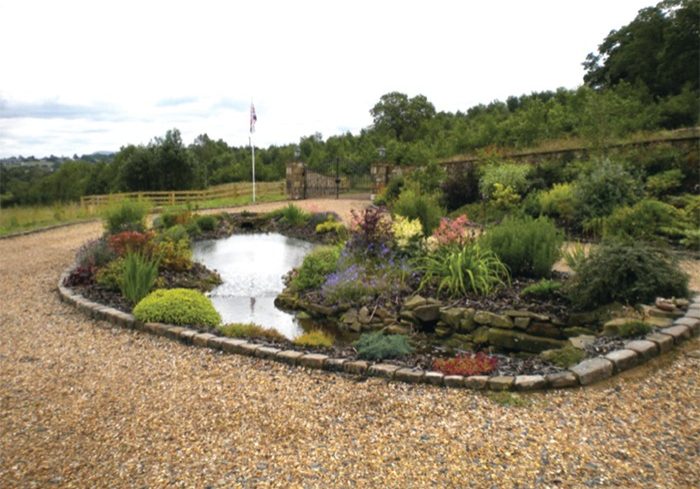
Border Lines | Gardening with Geoff Moss
by Geoff Moss
Gardener’s Diary with Geoff Moss
“The only moss you want in the garden”
Now that we are at the ‘back end of the season’ so to speak, we can start looking at the borders in more detail. This is a great time to be assessing and revamping or just altering the borders as the summer temperatures have cooled off but we haven’t quite reached the cold climate of the winter.
By this time the herbaceous perennials will be dying down so they can be lifted and divided, then as we get the colder weather drawing in, shrubs can also be moved, so why not take a look at your borders as we focus on structure, layout and impact of planting throughout the garden.
At this point we are putting our lists we have been creating to one side, unless some of the tasks are involved with the borders, in which case – bonus! What we are going to do is take a look at the border in question and look at a few items as we do.
- Are the plants overgrown?
- How is the planting laid out?
- Do all the plants have enough room?
- Are any plants hiding other plants?
- Does the border feel right in the context it’s in?
Depending on how you answer these questions will depend on your next move. For instance, if you feel the plants are overgrown the first task to do would be to start pruning them appropriately so you can see what space you have in the border.
However, if the plants aren’t overgrown but you feel the plants are crowded together the first task will be moving them about so they have enough room, and this will automatically change the border.
So work through these questions with regards to the border you are looking at and note your thoughts. The only question that could be difficult to work out is the last one but this simply means that a border with big structural display shrubs might not be correct next to a patio you use for entertaining.
Likewise, a border with small and detailed shrubs and perennials may notbe best placed at the bottom of the garden, whereas both these examples would be very suitable if they wereswopped round for position in relation to the garden.
Once you have worked out what needs doing, you may find that there is more than one task required on the border. In this instance there is a certain order of procedure; pruning must come first as you cannot work out what room there is with various amounts of foliage and branches in the way.
Next, the plants that are in a good position must be given enough room because if two plants are crowded the one that is moved may fit somewhere else in the border. Likewise, if any plants are hidden they need lifting ready to look for a new space or the plant hiding them requires lifting out of the way.
Once you have all the plants requiring moving out on the side of the border and any plants that are well positioned have the correct amount of space, you can start replacing the plants that have been moved.
To work out positioning of plants in a border whether they are new or have been moved around the border or have come from another border, it is best to place the plants on the surface first. This means you can shuffle plants around in their position to get best effect or use of space and you can also swap positions of plants around without too much work. Use this time to play around with different styles and effects as you will find that plants in different positions will give different effects.
You may also find that only some of the plants will fit back in the border or you may find there are still gaps once all the suitable plants are back in the border. In this instance don’t panic. You can either use plants from elsewhere in the garden as they become available or simply fill the gaps with new plants from a nursery or garden centre.
At this point I am conscious that we are touching on quite a few subjects within gardening that can be quite in depth and there is more to come. However, don’t despair as you can always seek further information through the ‘contact us’ button on my website.
Now as always we will pause for breath after all this in-depth technique, so let’s have a look at the top tips for this time of year.
Tasks to do: October/November
- Cut back herbaceous perennials like geranium, comfrey, and cornflower for a second flush of growth before winter
- As the temperature cools, lift and divide perennials before they die back for winter
- Dig out pernicious weeds like bindweed, couch grass and groundelder by forking through the soil and teasing the roots out – the remaining roots will not have chance to get hold before winter and the weeds will be weaker next season
- Carry out general pruning, particularly on summer flowering shrubs – beware of frost
- Protect tender plants from the frost by wrapping with bubble wrap or horticultural fleece.
Right, back to our borders, I promised last month that we would look at all the issues with borders. However, as there are so many subjects affecting border work I will have to be brief on many of them due to focusing on the layout and care of the borders earlier, which is a large part of what governs borders but is not everything related to them. So get ready for a whistle-stop tour of other issues related to borders.
Generally, healthy plants will fend off pests and diseases. However, if they are affected they will show symptoms of the problem and it’s best to note the symptoms and find the offending problem in reference books or in the internet.
Likewise with sickness in plants – e.g. nutrient deficiency – climatic problems will present in a similar way through symptoms in the plant. However, if you suspect a climate issue, simply move the plant to a different place in the garden where conditions will be different and see if this helps. If not, look more in depth at what is causing the problem; moving plants generally needs doing in autumn through to early spring, due to the plants losing less water from the leaves through evaporation, as the loss of water puts pressure on the roots while they are trying to establish. Again, conifers must only be moved in autumn or winter due to rain being shed from the canopy rather than dropping through and exacerbating this issue. Design of borders is many and varied, so feel free to use your imagination or gain inspiration from books and the Internet or the range of gardens we cover in our getting out and about spot…which leads me nicely on to our focus for this column, which is following on from last time looking at garden festivals; why not take a sneaky peek into other people’s gardens? If you don’t know them, just look over the fence or wall. Front gardens are great for this. However, if you do know them ask if you can take a look round. I do it all the time when I am out and about, and it’s amazing what ideas you can pick up.
I would like to mention at this point that while writing this month’s column I found out that a garden in Whitehall, Darwen, that I look after has achieved third prize in Whitehall in Bloom, which just ties in nicely with looking at other gardens.
So enjoy your border work, then when you are done enjoy looking at other people’s work and don’t forget to send me your thoughts on how it’s all going through the ‘contact us’ button on my website. Happy gardening and remember the other ways to find me:
Listen to Geoff on BBC Radio Lancashire, Gardening and Outdoors Show, Sundays 11am-2pm (usually 3rd or 4th Sunday between 1pm and 2pm)
Shackleton’s Home and Garden, Clitheroe Road, Chatburn (usually 2nd Sunday)
Look out for my sign written van – Garden Visions.
www.garden-visions.co.uk






